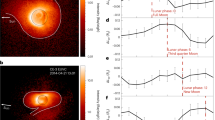Abstract
Seismology provides a powerful tool for probing planetary interiors1,2, but it has been considered inapplicable to tectonically inactive planets where earthquakes are absent. Here, however, we show that the atmospheres of solid planets are capable of exerting dynamic pressure on their surfaces, thereby exciting free oscillations with amplitudes large enough to be detected by modern broad-band seismographs. Order-of-magnitude estimates of these forces give similar amplitudes of a few nanogals for the Earth, Venus and Mars despite widely varying atmospheric and ambient conditions. The amplitudes are also predicted to have a weak frequency dependence. Our analysis of seismograms, recorded continuously from 1992 to 1993 at 13 globally distributed stations, shows strong evidence for continuously excited fundamental-mode free oscillations on the Earth. This result, together with other recent studies3,4,5, is consistent with our estimate of atmospheric forcing and we therefore propose that it may be possible to detect atmospheric excitation of free oscillations on Venus and Mars as well.
This is a preview of subscription content, access via your institution
Access options
Subscribe to this journal
Receive 51 print issues and online access
$199.00 per year
only $3.90 per issue
Buy this article
- Purchase on Springer Link
- Instant access to full article PDF
Prices may be subject to local taxes which are calculated during checkout


Similar content being viewed by others
References
Gilbert, F. & Dziewonski, A. M. An application of normal mode theory to the retrieval of structural parameters and source mechanisms from seismic spectra. Phil. Trans. R. Soc. Lond. A 278, 187–269 (1975).
Dziewonski, A. M. & Anderson, D. L. Preliminary reference Earth model. Phys. Earth Planet. Inter. 25, 297–356 (1981).
Nawa, K. et al. Incessant excitation of the Earth's free oscillations. Earth Planets Space 50, 3–8 (1998).
Suda, N., Nawa, K. & Fukao, Y. Earth's background free oscillations. Science 279, 2089–2091 (1998).
Tanimoto, T., Um, J., Nishida, K. & Kobayashi, N. Earth's continuous oscillations observed on seismically quiet days. Geophys. Res. Lett. 25, 1553–1556 (1998).
Goldreich, P. & Kumar, P. The interaction of acoustic radiation with turbulence. Astrophys. J. 326, 462–478 (1988).
Sagan, C. Structure of the lower atmosphere of Venus. Icarus 1, 151–169 (1962).
Howard, J. N., Burch, D. E. & Williams, D. Infrared transmission of synthetic atmospheres. Parts I–V. J. Opt. Soc. Am. 46, 186–190, 237–241, 242–245, 334–338, 452–455 (1956).
Gilbert, F. Excitation of the normal modes of the Earth by earthquake sources. Geophys. J. R. Astron. Soc. 22, 223–226 (1970).
Osaki, Y. in Progress of Seismology of the Sun and Stars (eds Osaki, Y. & Shibahashi, H.) 75–86 (Lecture Notes in Physics Vol. 367, Springer, Berlin, (1989)).
Wielandt, E. & Streckeisen, G. The leafspring seismometer: design and performance. Bull. Seismol. Soc. Am. 72, 2349–2367 (1982).
Kamal & Mansinha, L. Atest of the superconducting gravimeter as a long-period seismometer. Phys. Earth Planet. Inter. 71, 52–60 (1992).
Smith, S. W. IRIS: A program for the next decade. Eos 67, 213–219 (1986).
Dziewonski, A. M. & Woodhouse, J. H. An experiment in the systematic study of global seismicity: centroid-moment tensor solutions for 201 moderate and large earthquakes of 1981. J. Geophys. Res. 88, 3247–3271 (1983).
Bullen, K. E. & Bolt, B. A. An Introduction to the Theory of Seismology 4th edn (Cambridge Univ. Press, (1985)).
Beroza, G. & Jordan, T. Searching for slow and silent earthquakes using free oscillations. J. Geophys. Res. 95, 2485–2510 (1990).
Turcotte, D. L. & Schubert, G. Geodynamics Applications of Continuum Physics to Geological Problems (Wiley, New York, (1982)).
Acknowledgements
We thank R. Geller, S. Ida, M. Fujimoto and Y. Fukao for comments on this manuscript.
Author information
Authors and Affiliations
Corresponding author
Rights and permissions
About this article
Cite this article
Kobayashi, N., Nishida, K. Continuous excitation of planetary free oscillations by atmospheric disturbances. Nature 395, 357–360 (1998). https://doi.org/10.1038/26427
Received:
Accepted:
Issue Date:
DOI: https://doi.org/10.1038/26427
This article is cited by
-
Seismic noise between 0.003 Hz and 1.0 Hz and its classification
Progress in Earth and Planetary Science (2023)
-
Seismic noise wavelet-based entropy in Southern California
Journal of Seismology (2021)
-
Global Seismic Noise Wavelet-based Measure of Nonstationarity
Pure and Applied Geophysics (2021)
-
Alternative Method for Production of Pb Halide Perovskite with High Current Response for Photodetection Devices
Journal of Electronic Materials (2021)
-
Connection of Seismic Noise Properties in Japan and California with Irregularity of Earth’s Rotation
Pure and Applied Geophysics (2020)
Comments
By submitting a comment you agree to abide by our Terms and Community Guidelines. If you find something abusive or that does not comply with our terms or guidelines please flag it as inappropriate.



